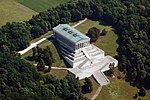Donaustauf Castle
Buildings and structures in Regensburg (district)Castles in BavariaHill castlesRegistered historic buildings and monuments in Bavaria

Donaustauf Castle (German: Burgruine Donaustauf) is a ruined hill castle located at a height of 424 m above sea level (NN) on a hill spur overlooking the River Danube by the market village of Donaustauf in the Upper Palatine county of Regensburg in the south German state of Bavaria. Donaustauf grew up during the Middle Ages under the protection of the mighty fortifications of the castle. Since 6 April 1986 the castle ruins have belonged to Donaustauf and, from 1997, the municipality had the castle made safe and renovated it.
Excerpt from the Wikipedia article Donaustauf Castle (License: CC BY-SA 3.0, Authors, Images).Donaustauf Castle
Prüllstraße, Donaustauf (VGem)
Geographical coordinates (GPS) Address External links Nearby Places Show on map
Geographical coordinates (GPS)
| Latitude | Longitude |
|---|---|
| N 49.03096418746 ° | E 12.207119464874 ° |
Address
Burgruine Donaustauf
Prüllstraße
93093 Donaustauf (VGem)
Bavaria, Germany
Open on Google Maps







